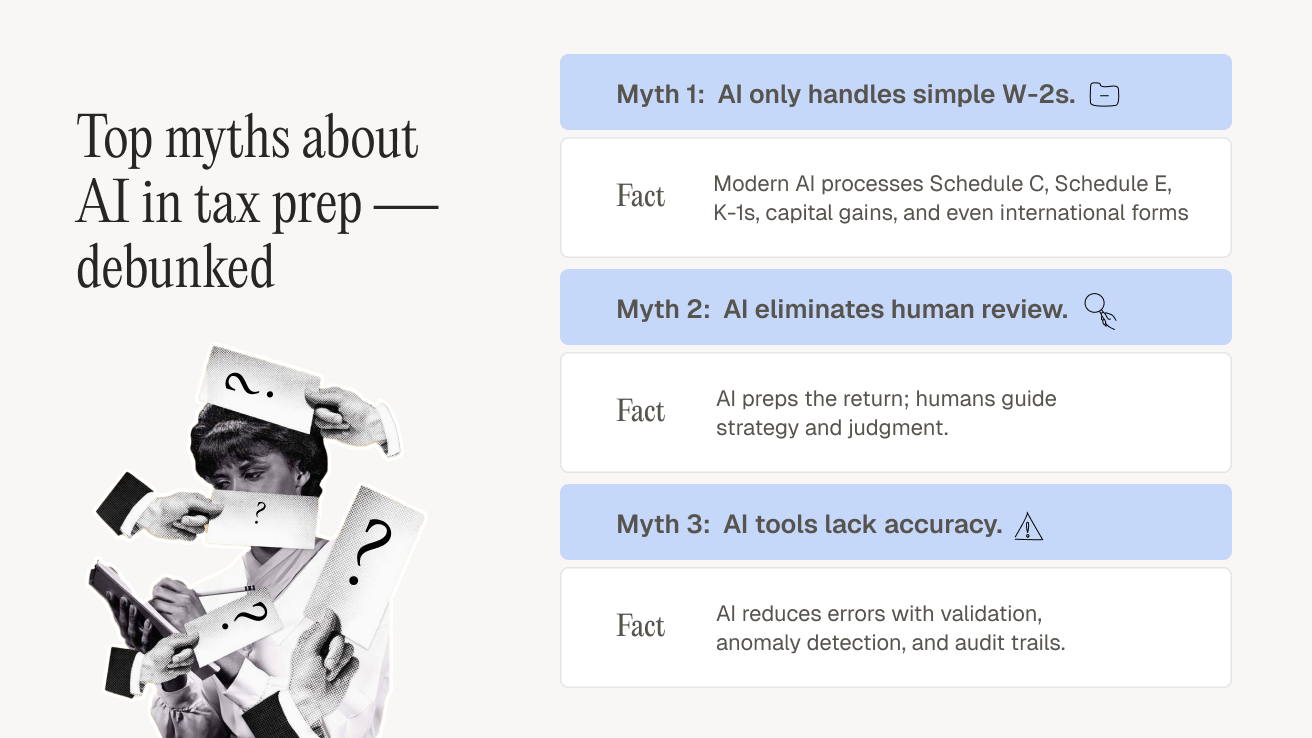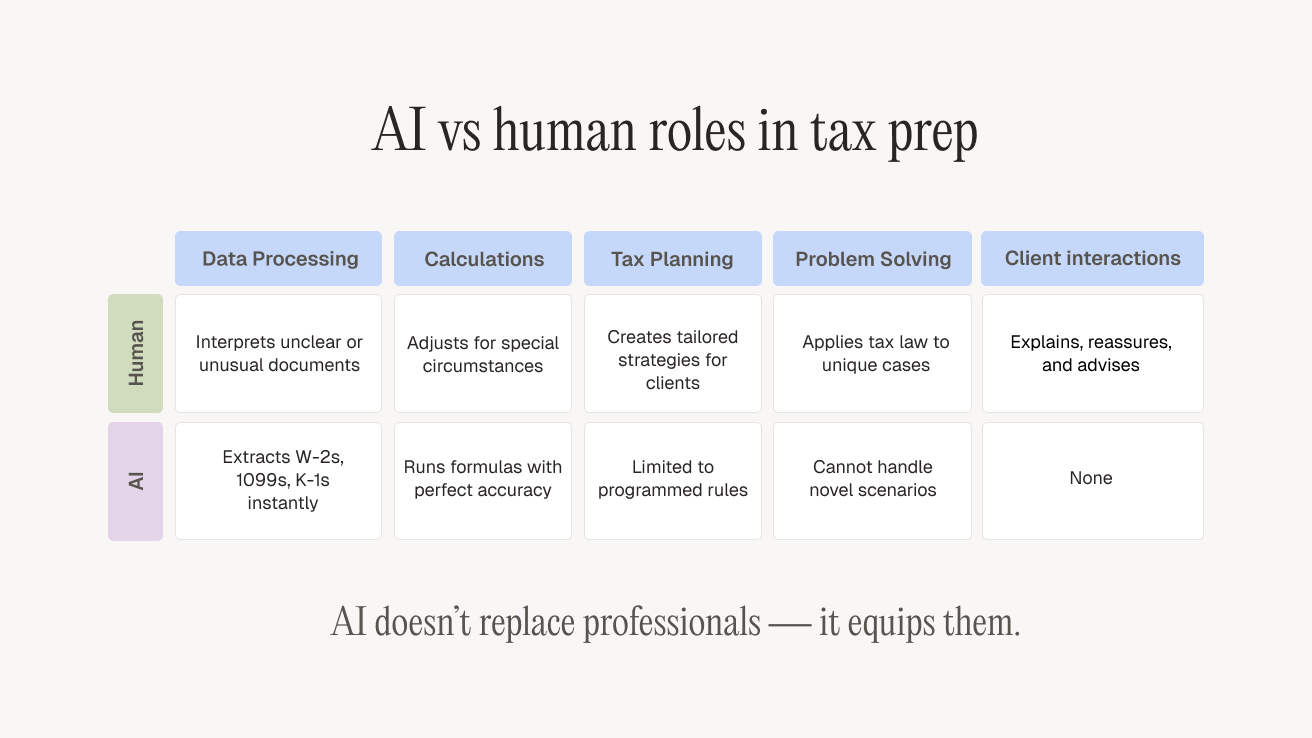Artificial intelligence isn’t just creeping into tax prep. It’s already here, changing how returns are prepared and reviewed. But with change often comes bad information.
Some firms assume AI can only handle simple W-2s. Others believe it’s sloppy or risky under IRS scrutiny. The truth is simpler: AI does the grunt work faster and more consistently than humans, while professionals stay in charge of strategy, planning, and judgment.
Here’s a complete breakdown of what AI can actually do—and what’s just noise.
Can AI really handle complex tax returns?
Yes. Complexity doesn’t scare AI. Multiple income streams, K-1s, investments, even international considerations—all of it can be processed automatically.
Modern systems extract data from W-2s, 1099s, K-1s, and supporting schedules, mapping values into the correct fields instantly. Instead of reading line by line, AI scans entire documents and looks for relationships between numbers, catching patterns faster than a human eye.
Tests show AI accuracy rates rival experienced pros for extraction and form completion. The difference? AI doesn’t fatigue or transpose digits at 2 a.m. You still need human review for planning decisions, but the heavy lifting is already done.
Breaking down myths about AI tax software

1. AI only works for simple returns
Wrong. Early tax software was limited. Modern AI can process:
- Schedule C (self-employment)
- Schedule E (rentals)
- K-1s (partnerships/S-corps)
- Capital gains + dividends
- Foreign income reporting
Machine learning lets systems recognize hundreds of document types, even when formatting varies. That’s how AI goes well beyond “just W-2s.”
2. AI will eliminate human review
No. AI + humans is the winning combo.
AI does:
- Extraction and calculations
- Consistency checks
- Cross-referencing across docs
Humans do:
- Strategy and tax planning
- Law interpretation
- Client judgment calls
- Final sign-off
AI preps the return. Humans deliver the value.
3. AI tools lack accuracy
Also wrong. Human prep is where most errors creep in — typos, transposed numbers, overlooked forms. AI applies rules consistently, every time.
With built-in validation, AI flags:
- Missing forms
- Math errors
- Inconsistent entries
Year-over-year anomalies
And unlike traditional prep, AI platforms leave an audit trail you can trace from document to form. That’s accuracy plus transparency.
Are AI tax returns riskier under IRS scrutiny?
No. The IRS doesn’t care if a return was prepared by AI or a junior associate. They care if it’s accurate.
Red flags for audit are the same as always:
- Income mismatches
- Outlier deductions
- Missing schedules
- Big deviations from prior years
Quality AI platforms reduce these risks by enforcing compliance with e-file specs and IRS formatting. Add human review, and you’ve got a stronger safeguard than manual prep alone.
Why AI is not replacing tax professional anytime soon
AI handles process. Humans handle judgment. Period.

AI can’t negotiate with the IRS, explain tax implications to a nervous business owner, or design a five-year growth plan. Professionals remain the value drivers, vital for:
- Responding to IRS notices
- Representing clients in audits
- Making elections that require professional judgment
- Providing advice on business structure or timing of transactions
Common pitfalls and how to avoid them
AI makes prep faster, but you still need controls.
Overreliance on automation. AI only processes what it’s given. Missing docs = missing data.
- Verify all documents are uploaded.
- Compare source docs against extracted data.
- Run year-over-year checks for gaps.
Failing To validate data. Bad scans or mislabeled files can throw results off.
- Ensure clean documents.
- Reconcile totals across schedules.
- Review flagged anomalies.
Ignoring state-specific rules. Federal compliance ≠ state compliance.
- Pay attention to apportionment and local taxes.
- Confirm the AI platform incorporates state-level updates.
Securing data and maintaining compliance with AI taxes
Tax data is gold for hackers. Any AI platform worth using must prove it’s secure. Look for:
- SOC 2 Type II certification
- End-to-end encryption
- MFA and role-based access
- Logged audit trails
- Clear data retention + deletion policies
Filed builds all of this in by default. Security isn’t optional when you’re moving client data at scale.
Elevate tax preparation with intelligent automation
AI isn’t consumer-grade “do it yourself” software. Professional platforms like Filed are built to support tax pros, not replace them.
Benefits firms report:
- 75–90% time saved on data entry
- More returns processed with the same staff
- Consistent, standardized workpapers
- Review-ready documentation every time
That’s why firms facing staffing shortages or scaling fast are moving to AI prep now, not someday.
Filed automates the grind, integrates with your current stack, and hands your team review-ready returns.
Want to see Filed in action? Interested firms can apply for early access at filed.com/early-access
FAQs about AI tax solutions
What forms can AI handle?
Schedule C, Schedule E, Schedule D, business returns (1065, 1120S, 1120), and international forms (8938, 5471).
How does AI integrate with current tax software?
Filed connects via secure APIs to platforms like UltraTax, CCH Axcess, Lacerte, and Drake.
How much time does AI save?
Firms report 75–90% time savings on document processing and data entry.
What security standards matter most?
SOC 2, encryption, MFA, role-based access, and detailed audit logs.
The myths are dead. AI isn’t risky, inaccurate, or limited. It’s the tool firms need to process returns faster, scale capacity, and keep professionals focused on the work that matters.




.png)

